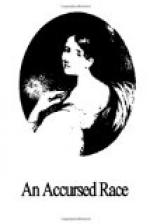The French Cagots tried to destroy all the records of their pariah descent, in the commotions of seventeen hundred and eighty-nine; but if writings have disappeared, the tradition yet remains, and points out such and such a family as Cagot, or Malandrin, or Oiselier, according to the old terms of abhorrence.
There are various ways in which learned men have attempted to account for the universal repugnance in which this well-made, powerful race are held. Some say that the antipathy to them took its rise in the days when leprosy was a dreadfully prevalent disease; and that the Cagots are more liable than any other men to a kind of skin disease, not precisely leprosy, but resembling it in some of its symptoms; such as dead whiteness of complexion, and swellings of the face and extremities. There was also some resemblance to the ancient Jewish custom in respect to lepers, in the habit of the people; who on meeting a Cagot called out, “Cagote? Cagote?” to which they were bound to reply, “Perlute! perlute!” Leprosy is not properly an infectious complaint, in spite of the horror in which the Cagot furniture, and the cloth woven by them, are held in some places; the disorder is hereditary, and hence (say this body of wise men, who have troubled themselves to account for the origin of Cagoterie) the reasonableness and the justice of preventing any mixed marriages, by which this terrible tendency to leprous complaints might be spread far and wide. Another authority says, that though the Cagots are fine-looking men, hard-working, and good mechanics, yet they bear in their faces, and show in their actions, reasons for the detestation in which they are held: their glance, if you meet it, is the jettatura, or evil-eye, and they are spiteful, and cruel, and deceitful above all other men. All these qualities they derive from their ancestor Gehazi, the servant of Elisha, together with their tendency to leprosy.
Again, it is said that they are descended from the Arian Goths who were permitted to live in certain places in Guienne and Languedoc, after their defeat by King Clovis, on condition that they abjured their heresy, and kept themselves separate from all other men for ever. The principal reason alleged in support of this supposition of their Gothic descent, is the specious one of derivation,—Chiens Gots, Cans Gets, Cagots, equivalent to Dogs of Goths.




